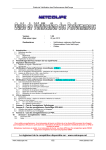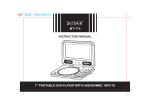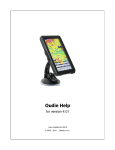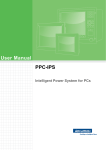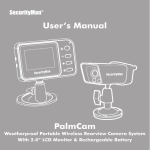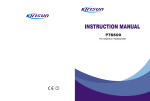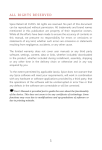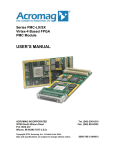Download GliderGuider USER GUIDE
Transcript
GliderGuider USER GUIDE Thank you for purchasing the GliderGuider. A hand-held computing device dedicated to the running of a selection of Moving Map applications as an aid to VFR navigation. Note! The GliderGuider is an aid to navigation, and must never be considered as a replacement for an air-map or any other legally required onboard equipment. It is nonetheless important however to become familiar with the functionality provided by the device and your chosen software application before use in flight. Please read this User Guide carefully and in conjunction with the User Manual and other relevant information provided by the application software provider. The software applications used with this device are sophisticated and fairly complex. The correct operation and usage of these applications is well beyond the scope of this User Guide. Please refer to the relevant Operators Manual for detailed information. Read it carefully and make sure that you familiar with its operation before using the system in flight! There are numerous User Settings which demand your careful consideration. This User Guide is intended to introduce the user to the various features and functions of the device itself, primarily as an aid to accessing and maintaining the relevant application software programs. Contents: 1. 2. 3. 4. 5. 6. 7. 8. Page Scope of Supply Specification The Internal Battery Getting to know your GliderGuider Getting Started Power Off Connecting to a computer Other Important Information 8.1. Location of application software – and associated user files 8.2. External Interfaces 8.3. COM Port settings for the internal GPS 8.3. Setting up a Bluetooth connection 2 3 3 4 15 15 16 16 17 20 20 21 1 www.gliderguider.net GliderGuider USER GUIDE 1. Scope of Supply: Item 1 2 3 4 5 6 Qty 1 1 1 1 1 1 Description GliderGuider Sucker Mount Holder Mains Charger USB Cable Micro SD-Card Comment Pre-installed. With ball & socket adaptor. Fits to the sucker mount, with stylus. UK style 3 pin plug, 5V at 2000mA. USB – A to USB Mini-B (5 Pin). Quality 4GB-Class 4 Storage Card. (with standard SD Card adaptor) 2 www.gliderguider.net GliderGuider USER GUIDE 2. Specification: Model Name Dimensions (mm) Net Weight (g) GliderGuider 135 x 85 x 13 (WxHxD) 182 Battery Operating Time Rechargeable LiOn, 3.7V, 1750mAh ~2 Hours CPU SDRAM NAND Flash Memory Local FLASH Memory Expansion Memory Huawei Hisilicon K3 / 460 MHz 128 MB 256 MB 256 MB Micro SDCard (Max 32GB) Operating System Operating Language Windows Mobile Ver. 6.1 English Display Type Display Resolution Display Brightness 5” TFT LCD, Sunlight Readable 480 x 272 800-1000 NITS Internal GPS Engine GPS Sensitivity GPS Channels SiRF Star III GDS3TW -147 dBm 20 Operating Temperature -20 to +50 deg. Centigrade Network USB COM4 COM7 COM8 Bluetooth – with support for file transfer & SPP USB 2.0 via 10 pin Mini B USB interface Reserved for the internal GPS Engine. Serial port – reserved for external data. Serial port – reserved for external data. Note: Specifications subject to change without notice. 3 www.gliderguider.net GliderGuider USER GUIDE 3. The Internal Battery: The internal battery will be partially charged on delivery, please place the GliderGuider on charge now - and ensure that the battery charge state is maintained before use using any combination of the Mains Charger, Car Charger or the USB Cable (via a suitably equipped computer interface). Battery LED - RED while charging. Battery LED - GREEN when charged When new, the internal battery has sufficient capacity to sustain normal operation for about two hours or more. It is therefore recommended that the unit be powered from an external 5V supply while in continued use. Note: the GliderGuider typically draws 700mA at 5V from the external supply (at max. brightness) while charging. Ensure that the source of the external supply is capable of delivering the adequate level of power for the intended duration of operation. Avoid running the internal battery completely flat by maintaining the charge state using any combination of the Mains Charger, Car Charger or the USB Cable (via a suitably equipped computer interface). 4. Getting to know your GliderGuider Power On/Off button. (top edge) Mini-B USB Interface & Micro SD Card. (side edge) Hardware Reset. (back of case) Use a ball point pen to access – only when really necessary! 4 www.gliderguider.net GliderGuider USER GUIDE 5. Getting Started: Power on – press and hold the Power On/Off button for approximately 1 second. The GliderGuider flash screen – always shown in landscape mode. The TODAY screen. The best place to start and finish each session. TODAY provides access to all Programmes, Files and Settings via the Start Menu (which will be familiar to Windows users). The two navigation buttons at the bottom of the TODAY screen, Glider Guider & Rotate Screen: Tap “GliderGuider” – to open a list of other supplied applications. Some may find the “Notes” application useful for note taking at briefings. Use it to make notes of notams, radio frequencies and any other information you might need. Both handwriting (use a suitable stylus) and keyboard entry is supported! Note: Not all applications are supported as there is no GPRS or WiFi network available. 5 www.gliderguider.net GliderGuider USER GUIDE Tap the “x” (top right) to close the current window. Tap “Rotate Screen” – to switch the screen format between Portrait and Landscape Note: Some Moving Map applications allow user configuration of the screen format and in such cases these User Settings will take precedence. If not, the application will start in the format selected using “Rotate Screen”. From the TODAY screen, tap “Start” Select “Settings” 6 www.gliderguider.net GliderGuider USER GUIDE Select “Owner Information”. Use the on-screen keyboard to enter your details – if required. This may prove useful in the event that you lose your GliderGuider! Tap “ok” (top right) to save and close. Select the “System” tab (bottom) Tap “Backlight”. Un-check the Tick Box and select maximum brightness – using the slider. 7 www.gliderguider.net GliderGuider USER GUIDE Select the “external power supply” tab. Un-check the Tick Box and select maximum brightness – using the slider. Tap “ok” (top right) to save & close. While here, take a moment to familiarise yourself with some of the other User Settings – such as Clock & Alarms and Regional Settings etc. Tap “ok” (top right) to save changes and close - when done. Finally, tap “x” (top right) to close the current window. Opening & closing the various applications: Note: Both examples (SeeYou Mobile & LK-8000) are shown here in the Portrait Format, this is just for convenience. Both can be run in Landscape Format if required. From the TODAY Screen - select the Moving Map application you wish to run. Note: The selection of installed applications may vary according to your preferences. 8 www.gliderguider.net GliderGuider USER GUIDE SeeYou Mobile - is a sophisticated and fairly complex software application and its operation is well beyond the scope of this User Guide. Please visit www.naviter.si to download the relevant Operators Manual. Read it carefully and make sure that you are familiar with its operation before using the system in flight! There are numerous User Settings which demand your careful consideration. Start by tapping “SeeYou Mobile”. Select the “Default” profile. Profiles are an important aspect of SeeYou Mobile. It’s via these Profiles that you will store all your User Preferences including glider type, registration, pilot details and other user settings. Be sure to read and understand this section of the Operation Manual! See You Mobile opens. Note: This is Screen 1 (see “1” at top left). See You Mobile provides for two screens (1 & 2) and you can setup each of these separately via your user settings. There are lots of them! The Nav Boxes are displayed at the bottom of the screen – again, you select which ones to display (on each of two screens) via the Settings. 9 www.gliderguider.net GliderGuider USER GUIDE Tap “Menu” (bottom right) to reveal the Menu page. Lots of nice toys here – but for the purpose of this exercise please tap “Settings”. This is the first of several “Settings” pages via which you will setup SeeYou Mobile. You will need to refer to the Operation Manual for details on each setting, but for the purpose of this exercise please tap “Next>” (top right). 10 www.gliderguider.net GliderGuider USER GUIDE Tap “Exit” Tap “Yes” to close SeeYou Mobile. Note the option to Save profile, and other parameters – depending on what (if any) changes you might have made during this session. Note: While SeeYou Mobile will open and run, it is a Trial Version only and requires payment and registration for continued use. See www.naviter.si for details. You will require a licence for SeeYou Mobile PNA version. 11 www.gliderguider.net GliderGuider USER GUIDE Back to the TODAY screen. LK-8000 - is a sophisticated and fairly complex software application and its operation is well beyond the scope of this User Guide. Please visit www.lk8000.it to download the relevant Operators Manual. Read it carefully and make sure that you are familiar with its operation before using the system in flight! There are numerous User Settings which demand your careful consideration Tap “LK-8000” LK-8000 plays a tune and opens at the Home Screen. From here you can select to run the Simulator, edit your Profile, Exit or Fly! For the purpose of this exercise, please tap “Fly”. 12 www.gliderguider.net GliderGuider USER GUIDE LK-8000 Initialises. Note the disclaimer – its really important! Press and hold in the centre area of the screen for 1 second. Note: LK-8000 supports several different screen taps, each accompanied by a distinctive tone – to make the interface more intuitive in the cockpit. 13 www.gliderguider.net GliderGuider USER GUIDE LK-8000 - Navigation Screen. Don’t worry about the error message at this stage, its just because we have yet to select the correct COM Port for the GPS data, this is just one of many user settings you will need to make! Tap the small aircraft symbol (bottom right) to reveal the Menu Page. Its from here that you navigate around all the settings in LK-8000. For the purpose of this exercise, please tap “Exit”. 14 www.gliderguider.net GliderGuider USER GUIDE Tap “Yes” to confirm Exit. Back to the TODAY screen. Note: LK-8000 is open source software and as such there is no user licence fee – it is free to use. Visit www.lk8000.it for more information. 15 www.gliderguider.net GliderGuider USER GUIDE 6. Power off Always close the Application Program in use and return to the TODAY screen before power down. Power off – press and hold the Power On/Off button for approximately 1 second. Tap “Yes” to power off. Note: A momentary press of the Power On/Off button will put the GliderGuider into “suspend mode”. Any applications running at the time will be maintained but power consumption is radically reduced. A further momentary press of the Power On/Off button will resume operation – before the “suspend” operation. 16 www.gliderguider.net GliderGuider USER GUIDE 7. Connecting to a computer: You will, from time to time require to connect your GliderGuider to a Personal Computer – primarily for the purpose of accessing and maintaining User Files including Log Files. Connect the device to your Personal Computer using the supplied USB Interface Cable. Power on – press and hold the Power Button for approximately 1 second. The GliderGuider flash screen – always shown in landscape mode. The “Connect Screen” shows. Select “Disk Drive” and tap “OK”. Note: “Active Sync” and “Windows Mobile Device Centre” are additional applications for Windows computers which support additional levels of connectivity with Windows Mobile devices. While occasionally useful, these are not essential for the normal day-to-day use of your GliderGuider device. However, some will find connecting the device to a computer more convenient than updating the User Files via the Storage Card. 8. Other Important Information: User Files: All Moving Map software applications require a selection of additional information in the form of computer readable data files in order to operate correctly: Terrain Map(s) Vector Map(s) For the area of intended flight – for location with respect to the ground. For the area of intended flight – for location with respect to ground topology. Airspace Map(s) For the area of intended flight – for location with respect to local airspace Waypoint File(s) For the area of intended flight - for location of waypoints (and other features) for the purpose of navigation flying tasks. Note: It is essential that these files are installed and maintained in accordance with the local flying laws and rules as well as any competition rules (where appropriate). Details regarding the selection and use of these files is beyond the scope of this User Guide. Please refer to the relevant Application Software and appropriate Operators Manual for further information. 17 www.gliderguider.net GliderGuider USER GUIDE 8.1. Location of application software – and associated user files: The application program files themselves are pre-installed on the supplied MicroSDCard. To locate or view the relevant file locations – proceed as follows: From the TODAY screen, Tap “Start” and then “File Explorer”. “My Device” (top) shows a list of all Folders & Files on your GliderGuider. Note: The list on your device may appear slight be different! Tap the down arrow to the right of “My Device” and Select “Storage Card” 18 www.gliderguider.net GliderGuider USER GUIDE See list of all Folders & Files on the Micro SDCard. Select “SeeYou” Note: Always take care when inserting the Storage Card into the device. Make sure that the card is properly aligned with the internal card slot before pressing it home. Some may find the use of a stylus (or similar) may help. See list of Folders & Files associated with the SeeYou Mobile application. 19 www.gliderguider.net GliderGuider USER GUIDE The User Files described above are stored in the “SeeYouFiles” folder. Tap “Up” (lower short-cut bar) to return to the full listing and note that the Log Files recorded by SeeYou will be saved in the “Flights” folder. 20 www.gliderguider.net GliderGuider USER GUIDE Next we will take a look at the file locations for LK-8000 Select “Storage Card” and this time select the “LK8000” folder. See list of Folders & Files associated with the LK-8000 application. The User Files described above are stored in the relevant named folders: _Waypoints _Maps _Airspaces Log Files recorded by LK-8000 will be saved in the “_Logger” folder. Note: We offer an annual update service to those customers who want it please contact us for details. 8.2. External Interface: The device supports a 10 pin Mini-B USB connector which provides options for interfaces to a variety of external instruments such as Vario Systems, Flight Recorders and FLARM units – please refer to www.gliderguider.net for further details regarding External Interfaces. 8.3. COM Port Settings – for the internal GPS: The internal GPS is assigned to COM 4. While this COM Port assignment can be changed it is not recommended to so as this may result in Port Conflicts. Typical communication port settings are: Baud Rate: Bits: DTR: 9600 8 No Parity: Stop Bit: RTS: None 1 No 21 www.gliderguider.net GliderGuider USER GUIDE Setting up a Bluetooth connection: Characteristics of Bluetooth devices vary considerably and as such the precise process involved may differ from that shown. Please use the steps outlined below a general guide. From the Start Menu – select “Settings”. Select the “Connections” tab – from the menu at the bottom. 22 www.gliderguider.net GliderGuider USER GUIDE Tap the Bluetooth icon to open the connection dialogue. Select the Mode Tab at the bottom and tick both boxes to enable the Bluetooth service. Note: Enabling the Bluetooth service will place an additional burden on the battery. 23 www.gliderguider.net GliderGuider USER GUIDE Select the Devices Tab and tap on “Add new device” – then tap “Add” in the bottom right-hand corner. The GliderGuider searches for all/any Bluetooth devices within range.. 24 www.gliderguider.net GliderGuider USER GUIDE One device has been found. In this case it’s a Bluetooth GPS Receiver which identifies itself as BN-806F. Note. Your device ID will almost certainly be different. Tap on “Next” in the bottom right. Most, but not all Bluetooth Devices will request a Pass Code. Please refer to the information supplied with your device for details. Key in the Pass Code using the on-screen keyboard and tap on “Next”. Note: some older Bluetooth GPS receivers have a default Pass Code of “0000” or “1234” while others are automatic. Please refer to the documentation supplied with the device. 25 www.gliderguider.net GliderGuider USER GUIDE The Device Added dialogue box confirms that the Bluetooth Device has been connected. Tap “Done” to close the setup dialogue. Your Bluetooth Device should then prompt to select a “service”. Most of the devices that we are interested (e.g. GPS Receivers) will require a Serial Port (SPP – Serial Port Protocol). Click the check-box to enable SPP and tap “Save”. 26 www.gliderguider.net GliderGuider USER GUIDE Tap the Com Ports tab (at the bottom of the screen) and tap on “New Outgoing Port” and tap Next to reveal the screen shown on the left. Use the pull-down menu to select the COM Port for your device. In this example it is COM9. Leave the Secure Connection un-ticked. Tap Finish to close the dialogue. Note: COM4, COM7 & COM8 are allocated and should not be selected. To check the system in this example - we are using SeeYou Mobile as it provides a useful Com Port Analyser which you will find in: SeeYouMobile>Menu>Settings>Hardware. 27 www.gliderguider.net GliderGuider USER GUIDE Tap on “Port Settings” and set the COM Port to match that which you set earlier (COM9 in this example). Note the other Com Port settings. These may vary according to your individual Bluetooth device. Tap ok to accept the settings and then “Terminal” to run the terminal emulator. If all is well, the Terminal screen should quickly fill with valid NMEA data – like that shown on the left. The Com Port and Settings are shown on the top right (COM9:9600,N,8,1 in this example). Note: An empty screen indicates that the assigned Com Port is open, but that there is a no data present, while an error message (e.g.“mcu failed!”) indicates that the assigned Com Port is not available. 28 www.gliderguider.net GliderGuider USER GUIDE If all s well, when you close the Setting Menu and return to the Moving Map you should see the GPS satellite status shown at the top left (3D/5 in this example). Enjoy your flight! Thank you! Thank you for following this User Guide – we sincerely hope that you will find it a helpful introduction to using your GliderGuider and wish you many years of satisfaction with the product. We are constantly seeking to improve our products and services and will welcome any constructive advice or suggestions regarding this User Manual. Allan Arthurs Managing Director 29 www.gliderguider.net





























